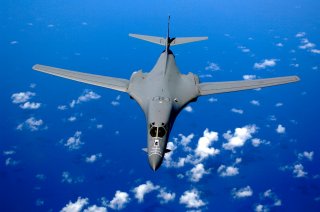The B-1 Bomber Isn’t Only Escaping Retirement, It Is Thriving
The B-21s will likely not be part of the force in larger numbers until the 2030s.
Here's What You Need to Remember: Also, given the complexity of the aircraft and the uniqueness of its production line, the B-21s will likely not be part of the force in larger numbers until the 2030s, a circumstance which continues to inform the Air Force’s ongoing move to extend and improve the mission life of the classic B-1.
The U.S. Air Force’s classic B-1B Lancer will live to fight another day, at least for several more years until enough B-21s arrive, a scenario which has inspired the service to extend the bomber’s service life and performance capacity through a series of upgrades and technical overhauls.
In recent years, the Air Force has been working on a range of massive improvements to the B-1, giving it improved weapons capacity, avionics, communications systems and engines.
A demo as recently as last year, for example, showed that the B-1 could increase its bomb-carrying load from 24 up to 40 in the internal weapons bay. The B-1 has also been increasing its carriage capacity of 500-pound class weapons by 60-percent due to what Air Force weapons developers explain as Bomb Rack Unit upgrades.
The B-1s also continue to get refurbished engines and improved targeting and intelligence technologies, service leaders told The National Interest.
A new Integrated Battle Station includes new aircrew displays and communication links for in-flight data sharing, a system which Air Force developers have explained includes machine-to-machine interface for on the move information adjustments such as a need to change target locations in flight. Part of this upgrade involves the use of what the Air Force calls the Fully Integrated Targeting Pod, a system that merges targeting pod controls with video feeds sent into the aircraft’s cockpit.
The B-1 can hit speeds of MACH 1.25 at 40,000 feet and operates at a ceiling of 60,000 feet. It fires several JDAMS: GBU-31, GBU-38 and GBU-54. It also fires the small diameter bomb-GBU-39.
The B-1, which had its combat debut in Operation Desert Fox in 1998, went on to drop thousands of JDAMs during the multi-year wars in Iraq and Afghanistan. The role of the B-1 during the Iraq and Afghanistan wars is lesser-known or at least lesser recognized, yet the bombing missions it performed over the years were considered crucial to U.S. military progress.
The eventual retirement of the B-1, which is now still several years away, will be aligned with the pace of arrival of new B-21s. The B-21 Raider program continues to make rapid progress, to the point where some think it may accelerate by as many as several years. However, even an expedited or fast-paced arrival of the new B-21s will not bring large numbers of aircraft to the force by the middle of the 2020s. The Air Force plans to acquire at least 100 B-21 bombers, and in recent months there has been very serious discussion among senior Air Force and Pentagon leaders about increasing that number substantially.
Also, given the complexity of the aircraft and the uniqueness of its production line, the B-21s will likely not be part of the force in larger numbers until the 2030s, a circumstance which continues to inform the Air Force’s ongoing move to extend and improve the mission life of the classic B-1.
Kris Osborn is the defense editor for the National Interest. Osborn previously served at the Pentagon as a Highly Qualified Expert with the Office of the Assistant Secretary of the Army—Acquisition, Logistics & Technology. Osborn has also worked as an anchor and on-air military specialist at national TV networks. He has appeared as a guest military expert on Fox News, MSNBC, The Military Channel, and The History Channel. He also has a Masters Degree in Comparative Literature from Columbia University. This article was originally published last year.
Image: Wikipedia.

